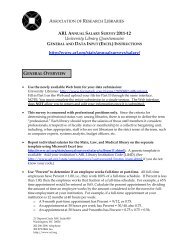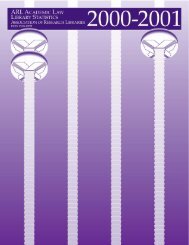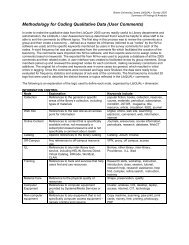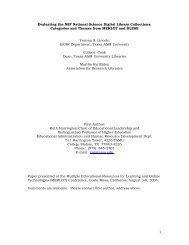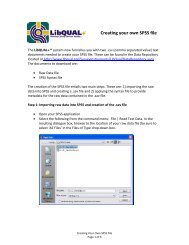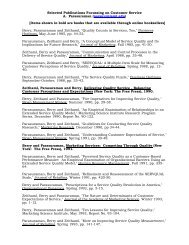You also want an ePaper? Increase the reach of your titles
YUMPU automatically turns print PDFs into web optimized ePapers that Google loves.
9. Total years of professional experience (Yrsexp). Define "professional experience" as indicated in the generalinstructions; for most professional staff members this will mean counting the years since the MLS degree wasawarded. When counting, do not subtract interim periods when an individual was not engaged in professionallibrary employment if these periods are short in relation to the overall professional career. Count an academicyear contract period as a full year. Be sure to include professional experience in previous positions and in otherinstitutions. Numbers should be rounded off to the nearest whole number.10. Rank. Rcsponses concerning rank should be limited to professional librarians and other professionals reportedin the survey who occupy the same ranks as librarians. Leave the rank column blank for professionals who donot occupy these ranks or if the column is not applicable. For example, if the Library Business Officer holds arank typically used for university administrators but not for librarians, do not supply a rank code for thatindividual or describe his/her rank in answering other questions, even if you have included salary and other datafor the Business Officer.If mUltiple ranking structures are used for librarians and these structures are substantially different and notequivalent, enter individual rank information only for that group which represents the largest fraction of "rankand-file"librarians.Do not usc roman numeral rank levels. Convert your local ranking system if necessary.Complete the column labeled "Rank Code" using the following codes:oA rank normally occupied solely by the library director and/or assistant and associate directors.9 Rank unknown; or, there is confusion or controversy regarding how to code this individual's rank.ILowest level in the rank structure.2 Next highest level in the rank structure.3-8 Successively higher levels in the rank structure. Highest number in this range should be equivalent tothe highest rank in the library's structure (unless the highest rank is occupied solely by the directorand/or assistant and associate directors).The maximum number of ranks reported here should not exceed the maximum number of rank-levelsreported in Part I for individual data under Rank Structure.When counting the total number of rank levels, include ranks that may be unoccupied at the present time due tocircumstances like unusually high turnover, hiring freezes, etc.II.Percent. Change the 100% appointment to less than that only for part-time people. Enter percent with decimalpoints. For example, a 65% appointment would be entered as .65. To calculate the percent appointment, if lessthan 1.00, which stands for 100%, divide the months the employee works by the number of months consideredto be the norm for full-time employment at your institution (or the number of hours per week an employeeworks by the number of hours per week considered to be the norm for full-time employment at your institution).For example, if a full-time appointment at your institution is 12 months, a 9-month part-time appointmentwould be .75, i.e. 75%. If a full-time appointment at your institution is 40 hours per week, an appointment at 30hours per week is also .75. To calculate the percent appointment for an employee who works 30 hours a weekand only for 9 months a year, when the norm for full-time employment is 40 hours a week and a 12-monthappointment, multiply the percent appointment per week by the percent appointment per year, i.e .. 75 x .75 ~.56.100



